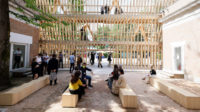The official exhibition from the U.S. pavilion at the 2008 Venice Architecture Biennale has arrived in the States—and it’s proving to be more relevant than ever. Although it was originally intended to serve as a showcase of American design for a foreign audience, this time the exhibition is being presented as an example, and even a call to arms, for those at home.
Into the Open: Positioning Practice opened at Parsons The New School for Design in New York on March 4 with new introductory text from the curators and a new exhibition design that reflects the change of context (chalkboards hanging on the walls, for instance, invite visitors to jot down their thoughts). When originally selecting projects for the exhibition last year, curators William Menking, Aaron Levy, and Andrew Sturm eschewed sculptural new buildings in favor of concepts by designers who are engaging communities and attempting to address social problems. It was a serendipitous decision. Now, with a full-blown economic crisis under way and a slowdown in architectural activity, the exhibition appears surprisingly pertinent.
The 16 projects included in the exhibition range from a “floating” public pool built on a decommissioned barge by New York-based Jonathan Kirschenfeld Associates to a bandshell made from 65 automobile hoods, reclaimed wood, and 3,000 plastic water bottles by San Francisco-based collective Rebar. San Diego-based Estudio Teddy Cruz presents meditations on urban conflict on both sides of the U.S.-Mexico border, and New York-based Deborah Gans offers portable housing systems designed to respond to a humanitarian crisis. According to the organizers, the common thread running through all of the projects is that each designer saw a need, and then rallied people around it to begin developing a solution. “Here, you have private architects actually defining the problem, and then often finding the client,” says Menking.
The curators argue that this is a uniquely American phenomenon. While many public projects in Europe are sponsored by the government and awarded via competition, the projects in this exhibition begin at the grassroots level and pull together many different players from the public, private, and nonprofit realms. “The architects and designers are kind of forced into it by this peculiarly American privatization of public space and public support,” opines Menking. “We’re trying to show that American architecture is about more than just form. It’s about ideas, the response to crisis, and the response to contemporary social issues.”
The exhibition’s focus on social improvement and public benefit made it particularly interesting to Parsons. “It addresses, in a very direct way, the concerns that are at the core of the school,” says Laetitia Wolff, Parsons’ director of strategic alliances, who brought the exhibition to the school. In fact, Wolff says Parsons is introducing more programs over the coming year that will emphasize research and activism. “There’s definitely this interest of looking at design and architecture through the lens of social responsibility, civic engagement, and a commitment to larger topics and global issues,” she says.
Citing the new economic reality and the new president in the White House, the curators say they believe that the present moment will lead to a new understanding of social space in the U.S. “I think a lot of that extravagant concern for form, at the expense of all else, by architects, is going to be put on the shelf, at least for the moment,” says Menking. “We’re going to see all kinds of different ways of thinking about how architects can remain engaged.” By providing examples of alternative practices through Into the Open, they’re hoping the exhibition begins to facilitate that discussion.
The exhibition runs through May 1 at the Sheila C. Johnson Design Center, 66 Fifth Avenue in New York. The school also is hosting a series of related public programs, including a conference on April 24. More information is available on the center’s Web site.



Post a comment to this article
Report Abusive Comment